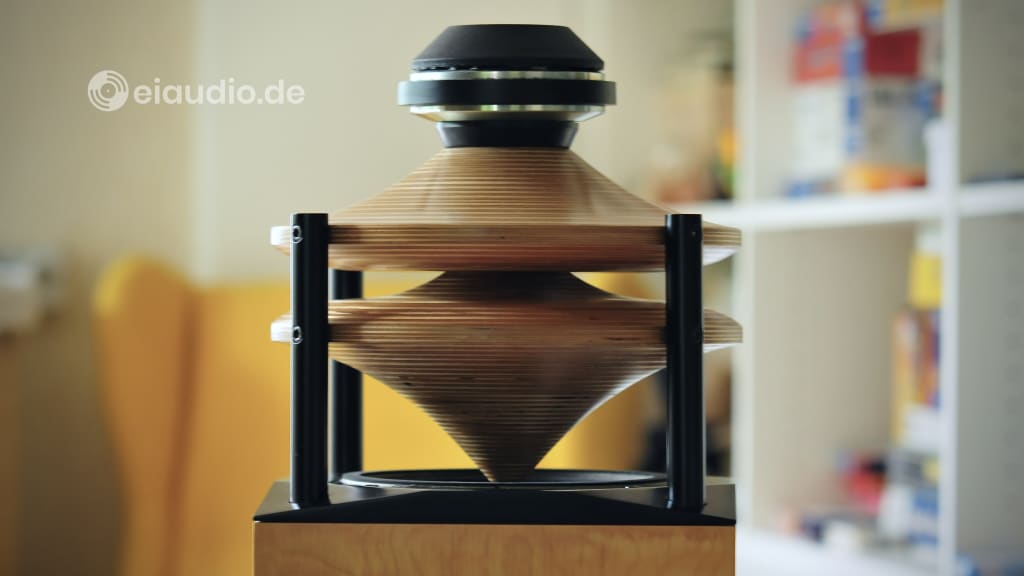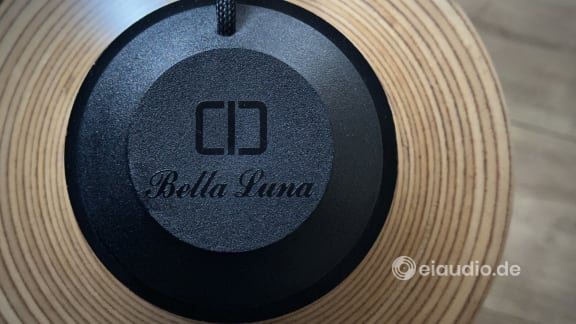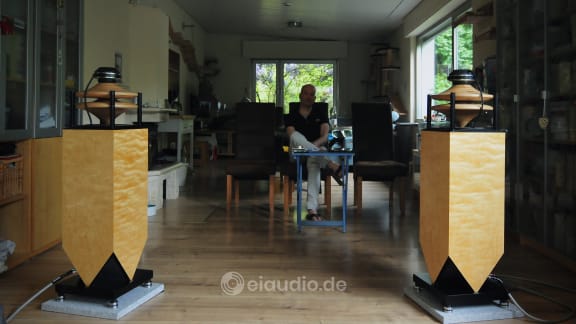Duevel Bella Luna
Published: 08/05/2023
Manufacturing date: 1999
Author: Karsten Hein
Category: Gear & Review
Tag(s): Loudspeakers
As human beings, we are natural collectors of information and ultimately become the medium through which this information is digested and passed on. This is especially true for those of us who, against all odds, have nurtured the childhood urge to explore. The reward is often little more than a brief and fleeting moment of enlightenment, a story to tell and perhaps a few bruises to heal. And the exploration is always incidental. Just when we think we have it figured out, it lights up, jumps sideways and makes its way across the paddock. Imagination, which is exploration, is an ever-elusive beast, and what is to be gained can therefore be little more than a relative aspect of truth. After all, who knows what will come next.
My background in sound exploration had brought me into contact with Alexi, who was eager to have his omni-directional Duevel Planet speakers reviewed. Pleased with my article, Alexi's colleague Michael asked me to review his Teufel M200 loudspeakers. On the day I returned the Teufels to Michael, I was introduced to Matthias, who had brought along his Devialet amplifier for a listening test. Looking at the way Matthias connected the amplifier to his MIT speaker cables and experiencing the sonic improvement the amplifier brought to the equation that is music, I was curious to see what else Matthias had in store. It turned out that he owned a pair of Duevel Bella Luna Diamante speakers. Now... Alexi had already told me about them.
The four of us made an appointment to test Matthias’ setup at his house a few weeks later. As it turned out, the Duevels were mostly stored in some private room most of the time and had to be brought out into the living room for the occasion. As setting up loudspeakers properly can be quite tricky, Matthias asked for some time to complete the project. In the meantime, I was looking forward to experiencing the combination of the large and lush-sounding Devialet amplifier with the majestic Bella Lunas. I was therefore prepared to accept that good things come to those who put in the time. Waiting, by the way, is an important skill for any explorer.
On the day we were summoned for the audition, we found the Bella Lunas positioned down the long walls of a deep and narrow living room. Three chairs were placed near the centre of the room with the speakers forming an equilateral triangle with the listening position, roughly in the lower third of the room. This meant there was plenty of space behind the speakers. The HiFi rack and system had been set up to one side behind the loudspeakers with the MIT Terminator 5 cables of 3.60m length easily reaching both channels and forming a long-sweeping curve towards the farther of the two speakers. I could see that Matthias had given some thought to the decoupling of his Bella Lunas and had decided on a combination of 3cm thick 40x40cm wide granite slabs coupled with dedicated speaker coasters made of high-grade steel and acoustic beads for a solid stand and effective vibration cancellation.
The latter had obviously also played a role in Matthias’ choice of audio rack. Finite Elemente of Brilon, Germany, had designed their legendary ‘Spider’, a versatile rack system that could be adjusted to accommodate many sizes of HiFi equipment and provided excellent cancellation of mechanical vibrations, both from the floor of the room and from the other devices inside the rack. The Spider rack housed (from top to bottom) a Thorens TD 320 MK II turntable with Ortofon Vero MC cartridge and an improved linear power supply, and a Pro-Ject CD Box RS transport paired with one Power Box RS Uni 1-way supply. A shiny silver Devialet D-Premier served as DAC and power amplifier. Matthias explained that this Devialet D-Premier, the first amplifier ever made by Devialet, had been technically upgraded to the specs of an Expert 250.
All cables presented were of carefully selected audio quality. For example, a Mogami Neglex 2549 microphone cable was used between the turntable and the Devialet, and a 110 Ohms Inakustik Exzellenz XLR cable was used for the CD transport. Matthias also used a MacBook Air M1 running Audirvana and Qobuz to stream music to the amplifier. It was obvious that this system had been set up with great care, and during the listening tests that followed, it never occurred to me that there was anything amiss that the use of a different cable or a more capable rack could have fixed.
As we began with our listening exploration, Alexi and Michael were kind enough to offer me the chair that was in the centre of the room and in the musical sweet spot. Michael sat on the opposite side of the room, behind the speakers and facing us. I closed my eyes to better concentrate on the music. Right from the start, I could hear that there were, indeed, large speakers playing in the room. They confirmed the tonal balance I had already enjoyed on Alexi’s Planets. Duevel speakers do not just hint at bass, they fully execute it, with attack and decay just like an instrument would. The Devialet Expert 250 added an extra layer of control to the music that, on lesser speakers and in smaller rooms, had sometimes been described as too much. However, in the few setups I have heard the Devialet, I have always found it to be one of the best-performing amplifiers I have ever heard.
After about two minutes of listening, I noticed a slight horn-like curvature in the midrange which surprised me. Could the open horn design of the Duevels produce some characteristic compression of the midrange, or was it perhaps the specific distance from the walls that produced this effect? As my eyes were scanning the room, I noticed that the MIT loudspeaker cable of the rear channel was laid out to cross itself and one of the power cables. There were also two power cables crossing behind the rack. I asked Matthias to help me free the cables and was relieved to find that the initial compression had disappeared and did not reappear for the rest of our session. It was yet another reminder of the absolutely sensitivity of the music signals passing between the components of a system.
Given the choice between the Pro-Ject CD transport and the MacBook M1, I surprisingly preferred the MacBook with Audirvana and Qobuz. The Pro-Ject had a much sharper top end and seemed less balanced and musical. It is possible that this verdict was the result of the pairing of two powerful and analytical components. However, the exact reason for the harshness was difficult for me to judge in the time available. To my ears, the Thorens TD 320 MK II turntable with Ortofon Vero MC cartridge sounded more pleasing and musical and, for a turntable, was extremely well-behaved. I would have expected nothing less from Matthias. On the other hand, vinyl did not offer the impressive dynamics of the M1 laptop. Hence, we decided to play mostly music from the Mac that afternoon.
Paired with a capable amplifier, such as the Devialet Expert 250, the Duevel Bella Luna had the potential to amaze. Although the room layout and furnishings were less than ideal, and only one of us could sit in the sweet spot at a time, the speakers offered a high degree of lifelike imaging and balanced tonality throughout. The levels of bass, midrange, and treble seemed just right for the occasion. Their ability to present plenty of musical detail quickly exposed the Devialet amplifier's digital SAM speaker optimisation software. Although SAM was said to correct bass performance right up to 150 Hz, it also took some of the realism of the vocal frequencies, leaving us hungry for the ugly truth rather than the artificially flattened curve. The timbre of instruments and the occasional traces of hesitation in vocals were naturally preserved by the Duevels, making for an entertaining and engaging listening experience throughout the afternoon.
With the possible exception of our Martin Logan electrostatic speakers and the elusive Snell C4, perhaps, the Duevels played more flawlessly than most of the loudspeakers I had heard, and they were able to do so without sacrificing homogeneity for the sake of detail where the source material allowed. Like all good speakers, the Bella Luna benefited from careful positioning in the room and from impeccable source material and amplification. When paired with aggressive sounding equipment or material, they were only too happy to follow suit. Given their size, they benefited from larger rooms and some distance from the walls. And although omnidirectional speakers were more forgiving with respect to the listening position, the apex of the stereo triangle remained by far the best spot for listening.
To preserve the afternoon’s exploration for posterity, Alexi, Michael, and Matthias allowed me to make a recording of the setup. The material chosen for the recording was Seal’s CD album Best 1991 - 2004 and the acoustic version of ‘Killer’.
< Horn Milling Process | Audio Test Sample >
Specifications
- Type: floor-standing 2-way loudspeaker
- Design: omnidirectional, vented cabinet
- Frequency response (±3dB): 40 Hz - 23,000 Hz
- Power handling (RMS): 150 watts
- High-frequency driver: 4,4cm titanium dome tweeter, horn-loaded
- Midrange-to-bass driver: 22cm dynamic, kevlar diaphragm
- Woofer specifics: die-cast chassis, M-roll surround
- Diameter of horn diffusors: 280mm
- Gap between diffusors: 47mm
- Crossover frequency: N.N.
- Crossover design: phase-linear
- Power sensitivity (SPL): 91 dB
- Nominal impedance: 6 Ohms
- Dimensions: (H) 1050mm x (W) 325mm x (D) 325mm
- Weight: 30 kg
- Country of manufacture: Germany
- Year(s): 1999 - 2023










